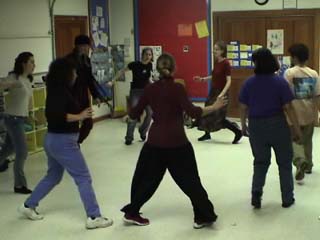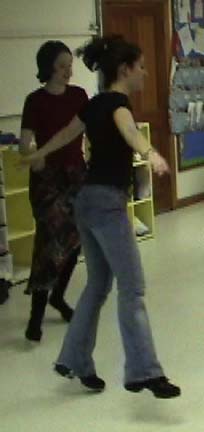Move with your feet, dance with your heartIsraeli dance is kept alive in Eugene via weekly sessionsBy Danielle WoodlingEvery Wednesday, a group of students and community members come together in Eugene to sustain a tradition that has been a part of Israeli culture for generations. From 8 p.m. to 10 p.m., Temple Beth Israel houses a session of Israeli folk dance that is free for students and community members.
Rayna Dushman, a University of Oregon senior, teaches Eugene's weekly Israeli dance session along with community member Tanya Sano. Dushman was exposed to ballet and gymnastics when growing up and was taught Israeli dance at a young age. Coming from a Jewish family, Dushman feels as though this is just one way in which she can stay connected with her culture. "It really helps me keep up with the traditions of my people; and it's something I can pass on to my kids," said Dushman.
According to the Israeli Dance and History website of South Dakota State University, the first "Israeli folk dance" on record was the Hora Agadati, named after its choreographer, Baruch Agadati, in 1920. The second choreographed dance was said to have been the Mayim Mayim, in 1944.
However, Dushman is quick to point out that being Jewish is not at all a prerequisite for one to attend the dance sessions; participants from all denominations are welcome. Although called "Israeli dance," the type of dancing that is performed incorporates steps from a number of different cultures including Arabic, Yemenite, Turkish, Latin and Greek.
All the dances Dushman teaches each week are classified as beginner level. Typically, each dance session begins with traditional circle dances. Everyone moves in a circular pattern, often holding hands and performing steps such as yemenites (the modern equivalent of a jazz "step ball change") and grapevines. Some of the circle dances taught are Mayim, Zemer Atik, Lo Ahavti Dai and Hinei Mah Tov.
As the session progresses, more steps are incorporated and circles tend to break up into the modernized line dances that are more frequently seen in Israel today. These line dances are a favorite of Dushman, who prefers the fast pace of Zodiak, Turkish Kiss, and Yakeilelo.
"I tend to like the more upbeat and modern dances - the ones with more patterns," says Dushman, "The moves and the music are more similar to today's popular culture."
Although some participants get frustrated with the vast number of step combinations, most find practice to be the most efficient means of improvement. One has the opportunity to learn by repetition in this type of setting. If a particular dance is too hard for some to follow, Dushman will take time go through the steps slowly without the music until people are comfortable enough to continue.
Esti Applebaum, who was born in Israel and now lives in Eugene with her family, is a frequent participant at these weekly dance sessions. She has been dancing ever since she could remember. She loves Israeli dance because of the connection it builds among community members and the electric energy it creates from the fluid movements of its patterns.
"Israeli dancing is done mainly as a group or as couples -- there is a sense of connection between people," said Applebaum.
In Israel, the intermediate and advanced dances are the most frequently performed. Applebaum says that in Israel, the more traditional dances are less popular because of their simplistic step combinations. However, the opposite is true of Eugene, where the higher dance levels are not taught because of their complexity and fast pace. Also, the majority of participants in Eugene do not have the cultural exposure that allows them to dance as frequently as they do overseas. In Israel, people dance for all types of celebrations including: holidays, weddings and parties.
"It's a lot of fun for the whole family," says Applebaum, "It's a part of our heritage. It symbolizes joy and happiness."
The Israeli dance sessions have been meeting regularly since 2001 through the Jewish campus organization of Hillel. The meeting places have varied since the dance became an organized event, but the group recently settled within the walls of Temple Beth Israel. The dancers hope to build up funds to afford the return of William Harvey, a professional Israeli dance coach, who had been hired to introduce new dance steps.
A group ranging from 10 to 35 people regularly attend the sessions. Dushman encourages all to join in the weekly festivities.
"The more people that are there, the more fun it is," says Dushman.
|

